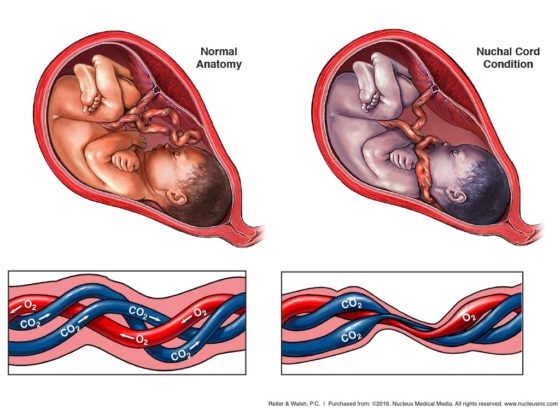Long Umbilical Cord
Risks, complications, and birth injury
Umbilical cord length varies greatly from pregnancy to pregnancy. An average umbilical cord is 55cm long. The shortest 5% of umbilical cords are shorter than 35cm, and the longest 5% are over 80cm (1).
If an umbilical cord is abnormally short or long, it can increase the likelihood of various pregnancy, labor, and delivery complications. Many of these are obstetrical emergencies that, especially when mismanaged, can result in serious birth injuries. Here, we will focus on unusually long umbilical cords.
What Determines Umbilical Cord Length?
The length of an umbilical cord is thought to be determined in part by how much the baby moves around in the womb; fetal activity pulls on the cord and stretches it out. Cord length may also be influenced by different protein expression patterns of genes involved in cell proliferation (1). It appears not to vary based on the baby’s weight, length, or sex (2).
What Are the Risks Associated with Long Umbilical Cords?
Unusually long umbilical cords can increase the risk of serious labor and delivery issues. Examples of long umbilical cord complications include:
Nuchal Cord

A nuchal cord is a complication in which the umbilical cord becomes wrapped around the baby’s neck one or more times. Multiple loops are more common when the umbilical cord is longer. One study found that the mean umbilical cord length was 68.55cm for one loop, 88.47 cm for two loops, and 96.15cm for three loops (2).
Nuchal cords occur frequently and can often be safely managed. However, if nuchal cords are tight around the neck or become compressed, the baby can be seriously deprived of oxygen. These issues are more common when there are multiple loops around the neck.
Umbilical Cord Prolapse
Normally, the baby exits the mother before the umbilical cord. In an umbilical cord prolapse, the umbilical cord comes out before the baby. This can happen when the mother’s ‘water breaks’ before the baby has moved into the birth canal. This is an obstetrical emergency because the cord is at high risk for compression, blocking oxygen and blood flow to the baby. In these cases, an emergency C-section is often necessary, with recommendations stating that they should occur less than 12 minutes from the onset of signs of fetal distress.
Diagnosing Umbilical Cord Complications
Umbilical cord issues can be diagnosed with an ultrasound, Doppler, and fetal monitoring. During prenatal testing, fetal distress caused by umbilical cord problems will show up on the fetal monitor as nonreassuring heart tracings. In addition, if there is a long-term (chronic) umbilical cord problem that is causing oxygen and nutrient deprivation, prenatal tests may show decreased fetal movement and intrauterine growth restriction (IUGR).
Management of Umbilical Cord Complications
Depending on the nature and severity of the issue, safe vaginal delivery may be possible. In some cases, though, specific maneuvers may be necessary to prevent cord compression. However, umbilical cord complications often necessitate delivery via emergency C-section. For this reason, it is very important that doctors closely monitor the health of the mother and baby during labor and delivery.
If a baby is oxygen-deprived due to an umbilical cord complication, they can be treated with hypothermia therapy. This involves cooling the baby’s core body temperature to a few degrees below normal for 72 hours. This treatment can prevent or minimize permanent brain damage, but it must be given right away. Usually it is only effective within six hours of the oxygen-depriving event, which often means within six hours of birth.
If physicians do not carefully observe a mother and baby for signs of umbilical cord issues, fail to intervene when necessary, or do not promptly provide hypothermia therapy to a baby who needs it, this is negligence. If this negligence harms the baby, it constitutes medical malpractice. In some cases, the consequences of medical professionals’ deviation from standard of care can be severe; improperly-managed umbilical cord issues can result in hypoxic-ischemic encephalopathy (HIE), cerebral palsy (CP), intellectual disabilities, and other lifelong conditions.
Legal Help for Umbilical Cord Complications
If you’re seeking legal help for harm resulting from an umbilical cord complication, it’s critical to choose an attorney and firm that focus solely on birth injury cases. ABC Law Centers: Birth Injury Lawyers has been helping children with birth injuries since 1997.
We have helped children throughout the country obtain compensation for lifelong treatment, therapy, and a secure future, and we give personal attention to each child and family we represent. Our firm has numerous multi-million dollar verdicts and settlements that attest to our success.
Sources
- https://emedicine.medscape.com/article/262470-overview#a2
- https://www.ncbi.nlm.nih.gov/pmc/articles/PMC3526711/